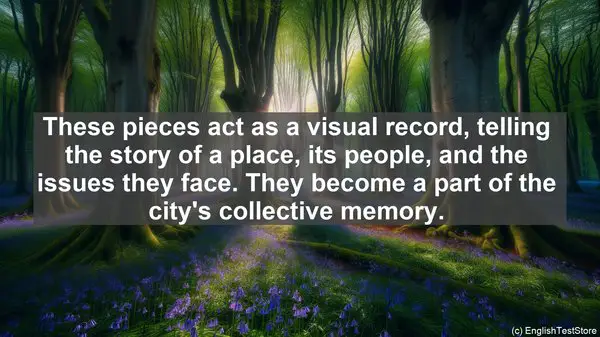Introduction: The Language of Urban Art
Today, we’re diving into the vibrant world of urban art and public installations. To truly appreciate and discuss these creative expressions, it’s crucial to have the right vocabulary. In this lesson, we’ll be exploring the top 10 verbs that will help you articulate your thoughts and observations. Let’s get started!
1. Transform: The Power of Change
Urban art has the incredible ability to transform a dull space into a captivating one. Artists often use their work to breathe life into forgotten corners, turning them into vibrant, thought-provoking areas. Whether it’s a mural or a sculpture, these installations have the power to transform the entire atmosphere of a place.
2. Engage: Creating Connections
One of the main goals of urban art is to engage with the public. It’s not just about aesthetics; it’s about creating a dialogue. Installations that engage the community, such as interactive pieces or those with a social message, encourage people to stop, reflect, and even participate. They become more than just decorations; they become catalysts for conversations.

3. Blend: Harmonizing with the Environment
Great urban art doesn’t exist in isolation; it blends seamlessly with its surroundings. Artists often take inspiration from the local culture, history, or even the architecture of a place. By doing so, they create a harmonious connection between the artwork and its environment, making it feel like an organic part of the space.
4. Evoke: Stirring Emotions
Urban art has the power to evoke a wide range of emotions. Whether it’s a whimsical piece that brings a smile to your face or a thought-provoking installation that leaves you deep in contemplation, these creations have a way of stirring something within us. They challenge our perspectives and make us see the world in a different light.
5. Preserve: Documenting the Present
In a rapidly changing urban landscape, some installations serve as a means of preservation. They capture a moment in time, documenting the present for future generations. These pieces act as a visual record, telling the story of a place, its people, and the issues they face. They become a part of the city’s collective memory.
6. Reclaim: Transforming Neglected Spaces
Abandoned buildings, empty lots, and neglected areas can be transformed through urban art. Artists, with their creativity, can reclaim these spaces, giving them a new lease on life. What was once an eyesore becomes a point of interest, drawing people in and revitalizing the neighborhood.

7. Interact: Breaking the Barrier
Unlike traditional art, urban art often encourages interaction. Whether it’s a piece that invites you to touch, sit, or even play, these installations break the barrier between the viewer and the artwork. They create a more immersive experience, blurring the lines between the observer and the creator.
8. Inspire: Fostering Creativity
Urban art has the incredible ability to inspire. For budding artists, seeing these installations can be a catalyst for their own creativity. They showcase what’s possible, pushing the boundaries of what art can be. But it’s not just artists; anyone who encounters urban art can be inspired, whether it’s in their own creative pursuits or in how they view the world around them.
9. Challenge: Questioning the Norm
Urban art is often a form of rebellion, a way to challenge the status quo. It questions the norms and forces us to think critically. These installations can be provocative, pushing us out of our comfort zones and encouraging us to reevaluate our beliefs and values.
10. Persevere: Art in the Face of Change
Urban art is not always permanent. It may face removal, weathering, or even vandalism. But the spirit of urban art is one of perseverance. Artists continue to create, knowing that their work may not last forever. It’s a reminder that art, like life, is transient, and it’s the process and the impact it has in the moment that truly matters.
